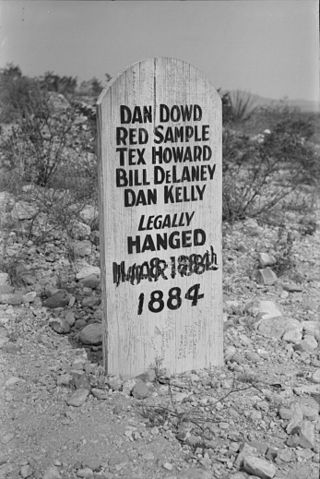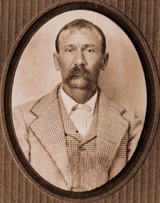George Scarborough was a cowboy and lawman who lived during the time of the Wild West. He is best known for having killed outlaw John Selman, killer of John Wesley Hardin, and for his partnership with lawman Jeff Milton, with the pair bringing down several outlaws during their time together.

Fairbank is a ghost town in Cochise County, Arizona, next to the San Pedro River. First settled in 1881, Fairbank was the closest rail stop to nearby Tombstone, which made it an important location in the development of southeastern Arizona. The town was named for Chicago investor Nathaniel Kellogg Fairbank who partially financed the railroad, and was the founder of the Grand Central Mining Company, which had an interest in the silver mines in Tombstone. Today Fairbank is located within the San Pedro Riparian National Conservation Area.

Albert "Burt" Alvord was an American lawman and later outlaw of the Old West. Alvord began his career in law enforcement in 1886 as a deputy under Sheriff John Slaughter in Cochise County, Arizona, but turned to train robbery by the beginning of the 20th century.

Charleston is a ghost town in Cochise County in the southeastern part of the U.S. state of Arizona. It was occupied from the late-1870s through the late-1880s, and was located in what was then known as the Arizona Territory. Located on the west bank of the San Pedro River, Charleston's economy was based on milling silver ore mined from nearby Tombstone in the community of Millville, located directly across the river.

Contention City or Contention is a ghost mining town in Cochise County in the southeastern part of the U.S. state of Arizona. It was occupied from the early-1880s through the late-1880s in what was then known as the Arizona Territory. Only a few foundations now remain of this boomtown which was settled and abandoned with the rise and fall of silver mining in and around the area of Tombstone.

Jefferson Davis Milton was an Old West lawman and a son of Confederate Governor of Florida John Milton. He was the first officer appointed to the U.S. Immigration Service Border Patrol in 1924.

William Larkin Stiles, better known as Billy Stiles or William Larkin, was an American outlaw in the Old West who, with partner Burt Alvord, led a small gang of train robbers while serving as a deputy sheriff in Arizona Territory.
Jack Dunlop, also known as John Dunlop, Jess Dunlop, John Patterson, and most commonly Three Fingered Jack was an outlaw in the closing days of the Old West, best known for being a train robber. Whether he had just three fingers on one of his hands is not confirmed.

The Cochise County Cowboys is the modern name for a loosely associated group of outlaws living in Pima and Cochise County, Arizona in the late 19th century. The term "cowboy", as opposed to "cowhand," had only begun to come into wider usage during the 1870s. In that place and time, "cowboy" was synonymous with "cattle rustler". Such thieves frequently rode across the border into Mexico and stole cattle from Mexican ranches that they then drove back across the border to sell in the United States. Some modern writers consider them to be an early form of organized crime in America.

Cochise County in southeastern Arizona was the scene of a number of violent conflicts in the 19th-century and early 20th-century American Old West, including between white settlers and Apache Indians, between opposing political and economic factions, and between outlaw gangs and local law enforcement. Cochise County was carved off in 1881 from the easternmost portion of Pima County during a formative period in the American Southwest. The era was characterized by rapidly growing boomtowns, the emergence of large-scale farming and ranching interests, lucrative mining operations, and the development of new technologies in railroading and telecommunications. Complicating the situation was staunch resistance to white settlement from local Native American groups, most notably during the Apache Wars, as well as Cochise County's location on the border with Mexico, which not only threatened international conflict but also presented opportunities for criminal smugglers and cattle rustlers.

George Emory Goodfellow was a physician and naturalist in the 19th- and early 20th-century American Old West who developed a reputation as the United States' foremost expert in treating gunshot wounds. As a medical practitioner in Tombstone, Arizona Territory, Goodfellow treated numerous bullet wounds to both lawmen and outlaws. He recorded several significant medical firsts throughout his career, including performing the first documented laparotomy for treating an abdominal gunshot wound and the first perineal prostatectomy to remove an enlarged prostate. He also pioneered the use of spinal anesthesia and sterile techniques in treating gunshot wounds and is regarded as the first civilian trauma surgeon.

The Skeleton Canyon shootout was a gunfight on August 12, 1896, between members of the High Five Gang and a posse of American lawmen. Following a failed robbery on August 1 of the bank in Nogales, Arizona, the High Fives headed east and split up. The gang's leader, Black Jack Christian, and George Musgrave got away.

Augustine Chacon, nicknamed El Peludo, was a Mexican outlaw and folk hero active in the Arizona Territory and along the U.S.–Mexico border at the end of the 19th century and the early 20th century. Although a self-proclaimed badman, he was well-liked by many settlers, who treated him as a Robin Hood-like character rather than a typical criminal. According to Old West historian Marshall Trimble, Chacon was "one of the last of the hard-riding desperados who rode the hoot-owl trail in Arizona around the turn of the century." He was considered extremely dangerous, having killed about thirty people before being captured by Burton C. Mossman and hanged in 1902.

Burton C. Mossman was an American lawman and cattleman in the final years of the Old West. He is most remembered for his capture of the notorious border bandit Augustine Chacon in 1902, though he was also a successful businessman who owned the large Diamond A Ranch in New Mexico.

The Bisbee massacre occurred in Bisbee, Arizona, on December 8, 1883, when six outlaws who were part of the Cochise County Cowboys robbed a general store. Believing the general store's safe contained a mining payroll of $7,000, they timed the robbery incorrectly and were only able to steal between $800 and $3,000, along with a gold watch and jewelry. During the robbery, members of the gang killed five people, including a lawman and a pregnant woman. Six men were convicted of the robbery and murders. John Heath, who was accused of organizing the robbery, was tried separately and sentenced to life in prison. The other five men were convicted of murder and sentenced to hang.

The Gleeson gunfight, or the Gleeson shootout, was one of the last gunfights in the Old West, having occurred during the transition period between the "Old" and the "New." On March 5, 1917, the sheriff of Cochise County, Harry C. Wheeler, and his deputy, Lafe Gibson, were ambushed by a gang of Mexican alcohol smugglers near the town of Gleeson, Arizona. During the battle that followed, Wheeler and Gibson fought off the attackers and confiscated their alcohol, wounding at least one man in the process.
William Kidder Meade was an American politician who served as a United States marshal and two-time member of the Arizona Territorial Legislature.

Bill Downing a.k.a. William F. Downing was a notorious outlaw during the Wild West era in Arizona. Downing had fled from the Texas Rangers posse who was after him when he came to Arizona. In Arizona, he was involved in the killing of William S. “Slim” Traynor and in various train robberies including the robbery of the Train Depot in the town of Cochise. Downing was so unpopular that even members of his gang couldn't stand him.
















